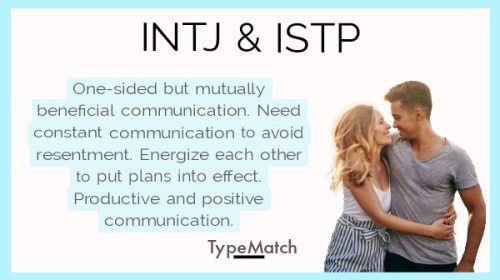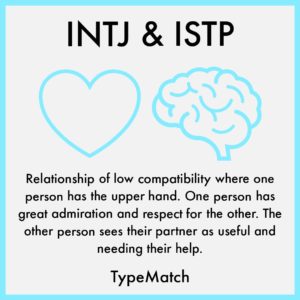ISTP and INTJ Relationship
Are ISTP and INTJ Relationships Compatible?
In INTJ and ISTP relationships, benefits are mutually exchanged between the two people involved. These types of relationships are unbalanced. In the TypeMatch dating and friendship app, we assign this pair a low compatibility score. Below we will explain the positives and negatives of this type of relationship as well as our advice.
Attraction
In an INTJ and ISTP relationship, one partner, known as the “benefactor”, the ISTP in this case, is always in a better position than the other partner, the “beneficiary”, the INTJ in this case. The person receiving the benefits admires the person bestowing them, and vice versa.
The abilities of the benefactor look impressive to the beneficiary from a distance, and their manners, behavior, and the way they hold themselves seem attractive. The beneficiary comes to consider the benefactor’s lifestyle and values to be worthwhile. The beneficiary experiences frustruation when the benefactor tries to help them to do something. They understand that their partner’s means very well, but reciprocity exists only initially.
Over time, harmony in INTJ and ISTP relations breaks down because the benefactor is dismissive of the arguments and conclusions of the beneficiary and even tries to impose their point of view and control their behavior. However, the beneficiary feels that it is difficult for them to refuse anything for such an admirable, authoritative partner.
Both INTJs and ISTPs come with their own challenges when it comes to dating. If you’re dating or trying to date an one of these types, download our guide with our top practical advice for dating an INTJ and ISTP.
Communication Compatibility
INTJ and ISTP relationships, there can be some tension while communicating. However, they still remain attractive to each other because they see their partner as somebody who could put their plans and ideas into effect. Consequently, the two look for a way to merge and gain each other’s trust. It only occurs when they are caught off guard, are sidetracked, comfortable, and have little control over their actions.
Communication between INTJs and ISTPs can often feel one-sided. Their connection feels like only one of them is putting in the work to make things happen or vice versa. It may cause one to get frustrated with their partner when they don’t seem to pay attention or are not living up to their standards. Without constant communication, both partners in an INTJ and ISTP relationship can become confused. If left unchecked, this will lead to poorer performance from both parties.
INTJ and ISTP pairs have a lot of momentum behind their activities and energize each other. To be most productive together, they must prevent things from becoming chaotic. If plans are disrupted, it will cause pain for both partners. In those moments, it’s best to try and remember that everyone has different communication styles and that it’s essential to be patient and understand where they’re coming from. If they can find a middle ground, they’ll likely have more productive and positive conversations.
INTJ and ISTP Relationship
In INTJ and ISTP relationships, the benefactor sees the beneficiary as someone needing their help to improve. They feel that the beneficiary is dependent and poorly adapted to life and that, without them, the beneficiary will be lost. So, they spend their time demanding, teaching, and explaining while the beneficiary tries.
Sometimes, people compare the INTJ and ISTP relationship to the relationship between an older and younger sibling. Other times, they compare supervision to the relationship between a parent and child. However, the beneficiary’s first and the benefactor’s second functions complement each other, making for a more caring and less competitive relationship than supervision.
ISTPs and INTJs who marry often find that their relationship becomes more like a friendship after marriage. While they may have been passionate and romantic, they often feel more confused and dissatisfied after tying the knot.
At the beginning of their relationship, the beneficiary feels proud and happy to have such an admirable person associated with him. Alternatively, the benefactor in these relationships may start to see the beneficiary as someone who is always doing something wrong and needs help. Usually, these feelings don’t stem from any one big problem but from mundane issues that arise from everyday life.
The benefactor seems to always be working and staying busy. The beneficiary experiences a lot of emotional ups and downs. Their state is alternates between hope and frustration, and pleasant feelings mix with bitterness. The beneficiary strives to emulate the benefactor in their methods of solving problems, and the benefactor is not opposed to teaching them their secrets. Over time, they become increasingly similar.

Partnership
In an INTJ and ISTP relationship, one person always asks for things while the other seems to have it all. Taking into consideration the social level of the partners is essential. If the receiver’s status is higher than that of the transmitter, there is a potential for fruitful mutual contact.
INTJs and ISTPs together usually experience an emotional rollercoaster. While this can often awaken their creative side, it also pushes them to make more mistakes because they cannot objectively assess their achievements. These types of relations are full of anxiety and negative anticipation, but at the same time, they improve imagination and give the person more confidence in their abilities. If they find themselves in this situation, it may help them to be able to generate some very innovative and original solutions ahead of the current situation.
Benefit partners and groups are very productive work groups, carrying out comprehensive policies in their sphere of activity. INTJ and ISTP relationships with an extraverted character on both sides tend to be more stable and effective, especially regarding business activities.

Our Advice for INTJs and ISTPs
INTJ and ISTP relationships may not appear to have any conflict. Usually, the benefactor initiates contact, and the two might feel some spiritual connection. However, these relations only last while the benefactor has something to give, and the beneficiary needs it. If this significant condition is no longer fulfilled, relations enter an unpleasant stage of development. The beneficiary may begin ignoring the benefactor completely or may start emphasizing the benefactor’s inability, provoking arguments and fights.
In INTJ and ISTP relationships, if two people are working together and one wants to establish control, they should try to develop an exciting idea that captures the other person’s attention. They shouldn’t demand an immediate response but rather let the person think about it. Chances are, the other person will accept the suggestion.
In any relationship, it’s essential to be reliable and to follow through on your promises. If you say you’re going to do something, do it. Unexpectedly canceling plans can damage trust, so it’s always best to communicate your intentions beforehand. When making requests, try to be considerate and take care of your partner. In difficult situations, it’s helpful to talk to a third party who can offer impartial advice and support. Overall, these relations are only recommended for family life if spouses are committed to joint work with many outside contacts.
More Resources for ISTPs & INTJs
Sources:
A.V. Bukalov, G. Boiko, “Why Saddam Hussein made a mistake, or what is Socionics”
Ekaterina Filatova “Art of understanding yourself and others”
Eugene Gorenko, Vladimir Tolstikov, “Nature of self”
I.D. Vaisband, publications on Socionics
Laima Stankevichyute “Intertype relations”
O.B. Slinko, “The key to heart – Socionics”
R.K. Sedih, “Informational psychoanalysis”
Sergei Ganin
Valentina Meged, Anatoly Ovcharov
V.V. Gulenko “Criteria of reciprocity”
V.V. Gulenko, A.V. Molodtsev, “Introduction to socionics”









